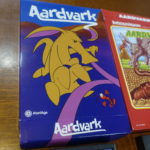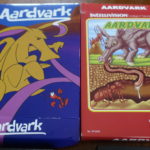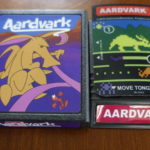Aardvark Review for Atari2600 and Intellivision Gaming Consoles
Before I get started I wanted to mention what inspired me to do this review today. Put simply this one is for Oscar Toledo G. He has recently gone through some serious personal problems. About a week ago he had proudly posted a photo of his award for 2018 best “Work in Progress” Homebrew Game. So with that I thought, it’s about time I review these games, it’s been more than a year since being released. So here we go…
Aardvark is a port of the 1982 arcade video game titled “Anteater”. Oscar Toledo G. began working on the project in December 2016 and it was released three years later for purchase on the Atari 2600 and Intellivision game systems. This review will be covering both releases. Aardvark is a single-player game.
GAME DESCRIPTION & GAMEPLAY:
The title screen artwork for both games match the box art. On the Atari, there are options to change your skill, hill, lives, and bonus lives, while on the Intellivision you can only your skill and hill.
The idea for the game is really clever. You play as an Aardvark at the top of an anthill, and control the animal’s tongue, trying to clear all the eggs or larvae out of the hill. As you play, the tongue can extend down the entire depth of the hill. It can be also retracted all the way back to the top. You must not let an ant or caterpillar touch any part of the tongue except for the tip. Worms can only be collected from behind and spiders are to be avoided. Speaking of which, spiders will appear if the Sun makes it all the way across the screen and night falls, the moon making its appearance. They tend to move toward the tongue. There are two queens on the bottom of each hill. If you eat a queen all the enemies on the level will be destroyed giving you a few free moments to eat more eggs. Eating a queen ant is also the only way to destroy the spiders. After clearing all the eggs on the screen you will be presented with a bonus point screen, then advance to the next more dangerous hill. The bonus screen is a little more elaborate on the 2600 version.
Controls
On the Atari, you control the tongue with the joystick which can move it in all four directions. Pressing the button will quickly retract the tongue. On the Intellivision you control the tongue with the disc and likewise pressing any button will also retract the tongue. I find the controls to be a tad more difficult on the Intellivision as it is easier to miss the turns you are trying to make, causing me to overshoot an area and having to back-track for example. This can be frustrating.
On the 2600 the game can be paused by toggling the Black/White switch, and on the Intellivision, the game can be paused by simultaneously pressing 1 and 9 on the keypad.
Scoring
The scoring is pretty much the same between both games.
Eggs are worth 10 points each, Ants 100, Red Ants and Caterpillars 100 points, Worms 200, Spider 200, and the Queens 1000.
Extra Lives
The default setting for spare lives is one every 20,000 points, but this setting can be adjusted from the title menu on the Atari 2600 version.
Strategy
Reading from the 2600 manual:
• Try to keep the tongue close to the middle of the screen so that you have more time to react when a new enemy appears.
• Your tongue moves at a particular speed so learn to time it carefully. Remember that retracting your tongue is faster than trying to move backward.
• Watch the speed of the ants, some are faster than others and some can turn around at unexpected times.
• It’s better to finish an anthill before night falls or the spider’s wrath will come over you
• An ant will loop around to the other side of it’s current tunnel, but if you eat one of them some time will pass will pass before a new one appears.
• Eating a queen ant is better when all enemies are on screen, but you need to be daring to attempt this.
Graphics
I really like the graphics on the Intellivision version. It looks, feels, and sounds not only like an Intellivision game but also like a decent port the Anteater arcade original. However, when contrasted with the Atari version, 2600 is the clear winner in this category. On the Intellivision, each layer of eggs is separated by a yellow line whereas on the Atari the layers are separated with something looking more like dirt and it even seems like there is a slight gradient from yellow to brown, and more closely resembles the arcade version. The horizon also looks significantly better. However, both versions did manage to throw in the mountains, and the Sun and Moon effects to represent time passing by. The tip of the tongues are a different color than the rest of the tongue and they nicely animate. The tip on the Intellivision version is slightly longer, generating in my opinion a more realistic-looking animation. The aardvark animates walking in and out of levels and even animates while pumping its tongue into the ground. I’d like to include this quote from Thomas Jentzsch, “We took great care to add some extra eye candy e.g. sky, mountain background, and underground platforms. And especially on the aardvark animations. There are quite a lot: walking, breathing, idling, pushing and pulling the tongue, eating, dying…”
It’s impressive work by the team including Nathan Strum, and it is appreciated! I’ll list all the credits in the tail portion of this video.
Sound
The target song & sound effects are identical on both platforms. Meaning the same songs and general effects play on both systems. However, the music sounds much richer and therefore better on the Atari version.
Music plays on the title screen and a song plays at the beginning of each level.
“In the Hall of the Mountain King” is played.
There is a sound effect for eating the eggs and for all the enemies, a sound effect for dying and there is a special sound effect for retracting the tongue.
Difficulty switches / Level ramp-ups
The Atari 2600 difficulty switches are not used in this game. However, on both versions, you can set the difficulty on the menus before beginning play. As the levels progress more enemies will be thrown your way and they start to move quicker. Your tongue speed also progresses with the new levels.
World Records
I did not find any official word records posted for these games on the Twingalaxies website, however, over on Highscore.com I did find a few scores:
On Easy 185,680 and on Expert 40,490 both by RetroGamersHub
From <http://highscore.com/game/?g=86467&enterscore=1>
Game variations
The atari 2600 version has a few additional options not available on the Intellivision. In addition to Normal and Hard modes, it also has Novice, Easy, Expert, and three Wild modes, Wild 1, 2 or 3.
These wild modes add obstacles that can block your path such as boulders. Enemy behavior is also modified.
The Atari 2600 version also adds High Score save support through the use of the Savekey or Atarivox plugged into joystick port 2. Each preset mode saves its own high scores. It will save your custom configurations and your most recently played game option is also saved.
Easter eggs
Although there are undoubtedly easter eggs in the game, I only know of the hidden bonus which is mentioned in the Intellivision game manual. If you’re able to clear an anthill without eating a queen ant, you’ll unlock a secret hidden level!
Suggestions for Improvements
This is one of those rare games that are nearly perfect in every way. Having said that about the only thing I could think of is maybe adding a two-player co-op mode, with two ant-eaters. That could be cool.
Packaging
Both games are packaged great and have their own original artwork and I like both versions. One could argue the Atari artwork is more kid-friendly with the Intellivision version looking slightly scarier. The artwork of the 2600 is credited to Nathan Strum while the Intellivision version gives credit to Garrett Gilchrist.
The 2600 manual has additional artwork on both sides of the manual and is slightly larger, hence easier to read and packs more information.
The same artwork is repeated on the Atari cartridge and the tongue imagery spills over to the end label, whereas on the Intellivision cartridge, as is traditional there is no image displayed. However, you do get artwork with the two included overlays for use with Intellivision.
Ports
This game was also ported to the Atari 8-bit family, Commodore 64, and Commodore 16 according to Wikipedia.
They also said “The game was ported to the Atari 2600 by Mattel in 1983 but never published.[4] ”
Purchasing Information
Aardvark for the Atari 2600 can be purchased on the Atariage store for $50.
I purchased Aardvark for Intellivision for $60 on the Intellivision revolution website but it looks like it’s currently out of stock.
The Atari 2600 ROM is now freely available to download on the forums of the Atariage website. I will include a link to the forum post.
https://atariage.com/forums/topic/319647-aardvark-rom-release/
You can purchase the Intellivision ROM from Oscar’s website store for about $10:
https://nanochess.org/store.html
Conclusion
Aardvark is another example of a retro-homebrew game out-doing the Arcade original! Both versions of Aardvark I am reviewing today are unique in their own way, however, if I had to pick my favorite I would have to go with the Atari 2600 version. The additional features in the 2600 version, including gameplay options and savekey features, help to separate it from the Intellivision.
Oscar Toledo G., and the team, did a fine job on both versions and he outlines the history of the games development within the game’s manual.
He also wrote an even more detailed account on his personal website:
https://nanochess.org/aardvark.html
Aardvark is an original creative concept that has been improved upon by these amazing releases. Oscar said it himself that “the end resulted in a game that is 500% better than the original, and even I would prefer it to the arcade because of the nice graphics!”
This game is fun and addictive. Just when you think you are doing well, a pesky ant creeps up out of nowhere and gets you! If you haven’t checked out Aardvark by now, what are you waiting for!
Highly Recommended!









